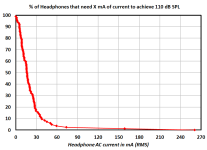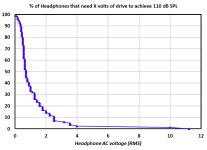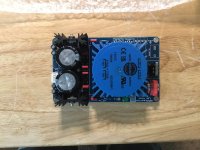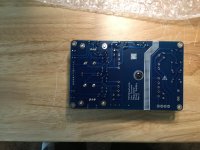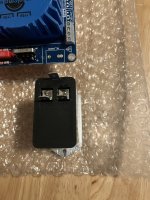Is it best to screw down the transformer? I’m guessing yes because of the weight? Do I need to use a special washer? Anything between the board and the underside of the transformer?
I don't bother, but in principle, yes, you may want to screw it down to reduce the mechanical stress on the soldered pins. The board has a center hole for Talema/AMVECO 70054 or 70064. Just use an M4 metric screw of appropriate length, perhaps with a normal flat washer. I don't think any special hardware is needed.
Use your personal judgement when boosting treble. Such a boost was part of various crossfeed designs (e.g. one published in 1971 by Linkwitz, see attached), but it may sound too bright, as Danyuk concluded in his 2005 article (also attached).a crossfeed switch and a high pass filter to boost treble a little
Attachments
How low can you go? 🙂
I saw on an earlier reply that Omicron would drive 25ohm headphones - mine are just a bit lower at 18ohms, but are fairly sensitive rated at 100-110db depending on whose tests you read. (Sennheiser Momentum). I guess Omicron would be good for these - I don't need it to be super loud. Does that seem OK?
I like the idea of a headphone amp that uses stuff I already have in my parts box. I have 5532s and I'm not afraid to use them!
I looks like I just missed the last GB.
I saw on an earlier reply that Omicron would drive 25ohm headphones - mine are just a bit lower at 18ohms, but are fairly sensitive rated at 100-110db depending on whose tests you read. (Sennheiser Momentum). I guess Omicron would be good for these - I don't need it to be super loud. Does that seem OK?
I like the idea of a headphone amp that uses stuff I already have in my parts box. I have 5532s and I'm not afraid to use them!
I looks like I just missed the last GB.
The lowest impedance headphones that Omicron has been tested with are the AKG K3003, with 8 ohm impedance and 125dB sensitivity. They perform magnificently with Omicron.
As mentioned above, the principal limitation of the Omicron's ultra-simple output stage is the current it can deliver to the load while still behaving nicely. It was designed to work 32 ohm, 100dB sensitivity cans, and should work with (somewhat) lower impedance, higher sensitivity can.
As mentioned above, the principal limitation of the Omicron's ultra-simple output stage is the current it can deliver to the load while still behaving nicely. It was designed to work 32 ohm, 100dB sensitivity cans, and should work with (somewhat) lower impedance, higher sensitivity can.
Funny thing planers were considered a high end driver and demanded a higher price, the the reality is after initial investment in tooling they are cheaper to build, Hifiman is bringing the prices down. Most of them are low impedance and probably will drive changes in headphone amp design when you see conventional drivers go away.
I guess lowering impedance is a long term trend, perhaps driven in part by the proliferation of low-voltage mobile devices. For example, JLH in June 1984 (page 29 - BTW that's the original publication of the JLH headamp) said:

These days, 2000 ohm is unheard of, 600 ohm is rare (e.g. Beyerdynamic T1 1st gen), and below 100 ohm is the norm.
Having said that, I used to own these 8ohm, 91dB/mW planars back in the 1980s:
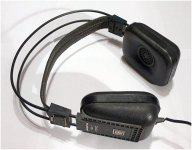
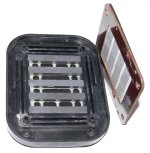
These days, 2000 ohm is unheard of, 600 ohm is rare (e.g. Beyerdynamic T1 1st gen), and below 100 ohm is the norm.
Having said that, I used to own these 8ohm, 91dB/mW planars back in the 1980s:


Last edited:
I think I will buy a pair of Focals before they disappear. There are times I like the pop of a conventional driver.
I extracted the data from (this article) and made a scatter plot and cumulative distribution plots. In my opinion, 110 dB Sound Pressure Level is very loud (too loud), but that's the reference he chose.
HOW TO READ THE PLOTS
The red curve passes through the point (30mA on the horizontal axis) , (17% on the vertical axis). This means 17% of all headphones in the survey, required 30mA RMS or more, to play at 110 dB SPL. Therefore it also means that 83% of all headphones required 30mA or less, to play at 110 db SPL.
The blue curve passes through the point (2V on the horizontal axis) , (14% on the vertical axis). This means 14% of all headphones in the survey, required 2V RMS or more, to play at 110 dB SPL. Therefore it also means that 86% of all headphones required 2V RMS or less, to play at 110 dB SPL.
I prefer this approach because it completely discards the unhelpful datasheet specifications named "impedance" and "sensitivity". Instead it focuses upon exactly those quantities a headphone amplifier designer cares about: output voltage and output current.
_
HOW TO READ THE PLOTS
The red curve passes through the point (30mA on the horizontal axis) , (17% on the vertical axis). This means 17% of all headphones in the survey, required 30mA RMS or more, to play at 110 dB SPL. Therefore it also means that 83% of all headphones required 30mA or less, to play at 110 db SPL.
The blue curve passes through the point (2V on the horizontal axis) , (14% on the vertical axis). This means 14% of all headphones in the survey, required 2V RMS or more, to play at 110 dB SPL. Therefore it also means that 86% of all headphones required 2V RMS or less, to play at 110 dB SPL.
I prefer this approach because it completely discards the unhelpful datasheet specifications named "impedance" and "sensitivity". Instead it focuses upon exactly those quantities a headphone amplifier designer cares about: output voltage and output current.
_
Attachments
Hey Alex, do you have a part number for the 4 position ac voltage selector? I ordered some phoenix terminal blocks, 277-1238-ND but the pin separation distance is too wide. I can’t seem to figure out how to find one with the correct spacing.
This one from Phoenix should work, and there are quite a few suitable parts with 3.81mm pitch (obviously you'd need one 4-position or two 2-position).
No real reason. Even though I had the Omicron chassis machined, I recall not having much material left after drilling/sawing one manually, so this time I tried the external fuse. I think if I redid the build I would go for an IEC inlet with fuse, convenient as you point out, but not sure of any differences in noise performance.
- Home
- Amplifiers
- Headphone Systems
- Omicron, a compact headphone amp with -140dB distortion
